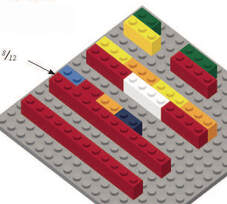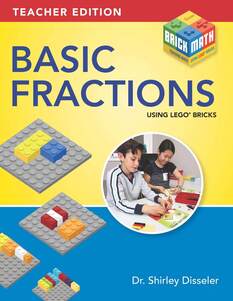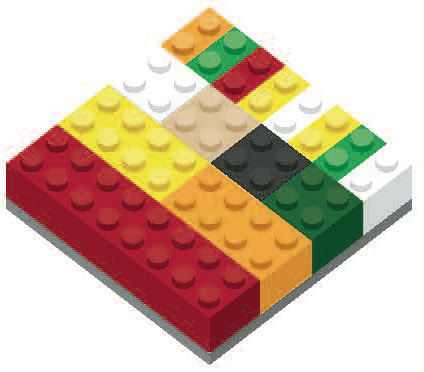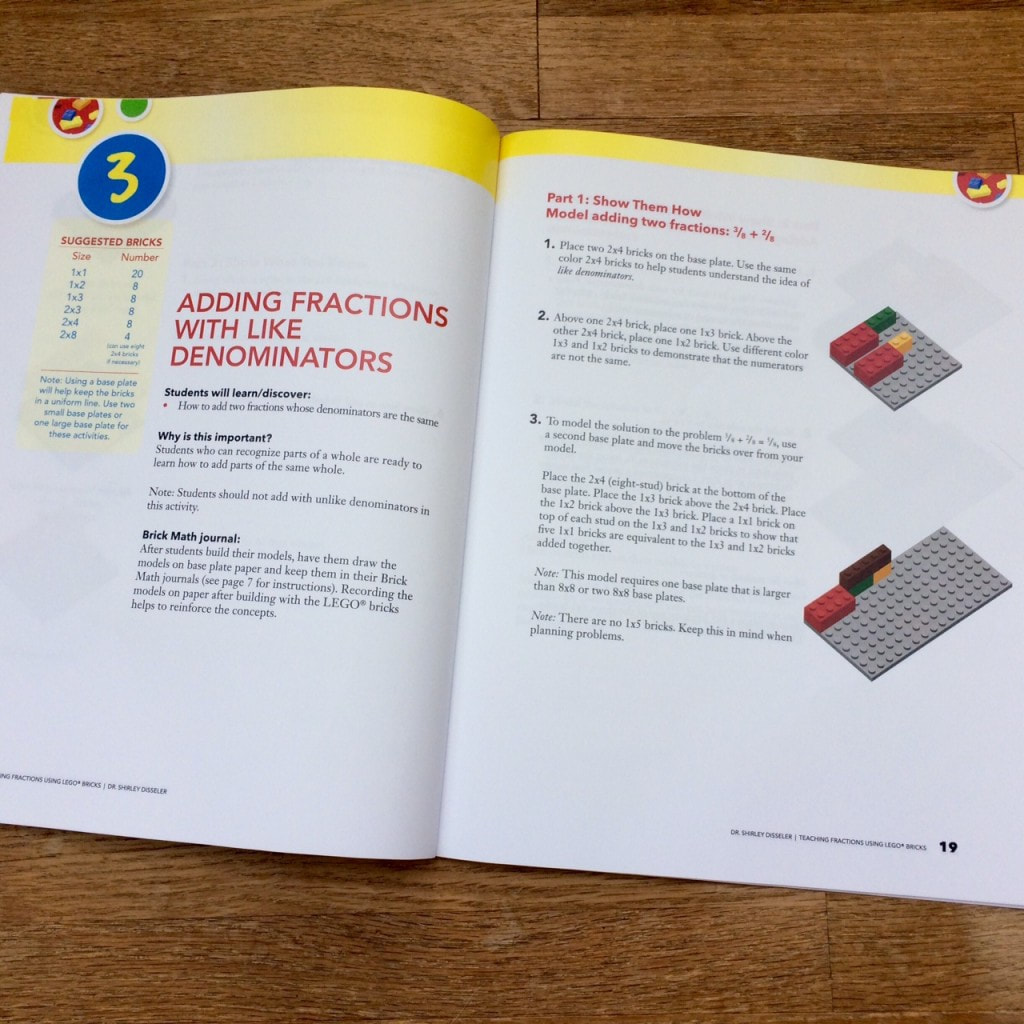|
The concept of Least Common Denominator (LCD) is key to being able to add and subtract with fractions that have unlike denominators or compare the size of different fractions. It's essential for students to thoroughly grasp the idea, and until they do so, they can't move forward with fractions. Modeling with LEGO bricks is the perfect way to teach students how to find the least common denominator. This method from Brick Math, called the "Fraction Train," starts with concrete representation of the math problem using bricks, to teach students exactly where the idea of a common denominator comes from.  1. Start by explaining that the process for finding Least Common Denominator with bricks is called the "Fraction Train." Have students build brick models of 2/3 and 3/4. Label them Fraction 1 and Fraction 2. 2. Discuss the value of the numerators and the denominators of 2/3 and 3/4. Ask students if the wholes are the same, and if not, which whole is larger? Explain that you will be finding the Least Common Denominator so you can compare the fractions.  3. Place one 1x3 brick on the baseplate, showing the denominator of Fraction 1, and under that, a 1x4 brick showing the denominator of Fraction 2. Now it's time to start building your "fraction train." You'll be building out a train of bricks that makes a rectangle.  Add enough 1x3 bricks to the top row, and enough 1x4 bricks to the bottom row, until both rows are the same length and the bricks form a rectangle. Count the studs in each row (12) to find the Least Common Denominator—the smallest number that both denominators can divide into evenly. Discuss the fact that 12 is also the equivalent whole for both fractions 2/3 and 3/4.  4. Now it's time to build the equivalent fractions for 2/3 and 3/4, using the Least Common Denominator of 12. Place two 1x12 bricks on the baseplate to represent the LCD of 12 for each fraction.  5. Look at the fraction train again. There are 4 bricks in the top row of the fraction train. This shows the number of 1x2 bricks (from the numerator of Fraction 1) that will model the numerator of the equivalent fraction. Count the studs in the numerator (8) and the denominator (12) . This shows that the equivalent fraction for 2/3 is 8/12.  6. Repeat the process for Fraction 2. Count the studs on the model of the numerator (9) and on the denominator (12). The equivalent fraction for 3/4 is 9/12. 7. Now the equivalent fractions can be compared, since they both have the same denominator. Have students look at the numerators of each fraction and determine which fraction is larger, based on having the larger number of studs in the numerator. Extend the learning by having students draw their models. Have them write a math sentence that compares the two fractions (2/3 <3/4 because 8/12 < 9/12). This lesson from Brick Math's Basic Fractions Using LEGO® Bricks is available FREE as the Brick Math Lesson of the Month for March 2020. Click HERE to sign up for the lesson, including Student Workbook pages.
0 Comments
 Whether you are a longtime LEGO® fanatic or new to the wonders of the plastic brick, it’s not hard to understand how well LEGO bricks work as a tool to teach fractions. The bricks can easily show concepts of benchmark fractions (½, ¼, 1/8, etc.), and since many students are familiar with them as a toy, they really enjoy using them in math class. Brick Math’s Basic Fractions Teacher Edition has a full curriculum for teaching fractions using LEGO® bricks. It starts with activities to answer the question “What is a fraction?” and moves through all the fraction topics – benchmark fractions, adding and subtracting fractions, factors, equivalent fractions, finding common denominators, and mixed numbers. Benchmark fractions (½, ¼, 1/8, ¾) are important for students to learn early on in their exploration of fractions. These are fractions they will see often, and understanding their value will help them make estimates in real-life situations. Benchmark fractions will also help students recognize that fractions are made from different-sized wholes. This is key to understanding fractions.  Here’s how to teach benchmark fractions using the Brick Math technique: 1. Start by placing a 2x4 LEGO® brick on a baseplate to represent the whole. Make sure students know that because there are 8 studs on this brick, it represents the whole of 8, and that is the denominator of the fraction.  2. Have students find a brick that shows ½ of this whole. Have them look for two bricks that are the same size and together take up the same space as the whole 2x4 brick when placed together. They should find either two 2x2 bricks or two 1x4 bricks. Explain that one of these bricks represents ½. The 1x4 or 2x2 brick has 4 studs, so the brick shows the numerator 4 of the fraction modeled here – 4/8 (or ½).  3. Ask students to find ¼ of the whole of 8 in the same way, with four bricks that take up the same space as the 2x4 brick. They should find four 1x2 bricks, and understand that one of these bricks shows ¼. With 2 studs on this brick, it models the numerator of the fraction 2/8 (or ¼).  4. Have students do the same process to find the brick that represents 1/8.  Then have students place these benchmark fractions bricks next to each other, to show the whole, ½, ¼, and 1/8 – and that each fraction is half of the one preceding it.  5. To show ¾, have students look for the brick that shows ¼, then find three of them and put them next to the whole. See if your students make the connection to the 6 studs on these bricks as the numerator of the fraction 6/8. They’ll do this by showing that the three ¼ bricks are equivalent to one 2x3 brick. Brick Math is a complete K – 6 curriculum that uses LEGO® bricks to teach math. Besides Basic Fractions, Brick Math topics include: Counting, Addition, Subtraction, Multiplication, Division, Basic Measurement, Fraction Multiplication, Fraction Division, Advanced Measurement and Geometry, and Decimals.
 The second edition of Basic Fractions Using LEGO® Bricks has just been published! This edition has even more ways to teach students about fractions than before. The first edition of Teaching Fractions Using LEGO® Bricks was the very first book written in the 22-book Brick Math series. Author Dr. Shirley Disseler went back to this best-selling book and thought it was time for an update. The second edition has lots of new illustrations of the brick models as well as several new chapters with content that was not included in the original book. Here's what's new in this second edition:
Right now, until December 15, the Brick Math FREE Lesson of the Month is from the Basic Fractions book, and it shows how to teach students to compare and order fractions, using the fantastic "fraction train" method. To download the free lesson, click here.  Learning fractions is difficult for many elementary school students. Even those who have succeeded in learning other math concepts may come up against a roadblock when they start to learn fractions. Research shows that the best way to learn fractions involves modeling fractions with manipulatives. Brick Math is the perfect way to learn fractions, because the manipulatives used in Brick Math are LEGO® bricks! Brick Math helps students learn fractions through its integrated program. The teacher leads students through step-by-step lesson plans. Using the bricks, students create models of the math as they learn. They then draw the models they’ve created and explain in writing how the models work. These different ways of interacting with the bricks lead to a deep understanding of fractions. Brick Math gives students the opportunity to create multiple solutions for problems instead of looking for only one right answer. Students who haven’t been able to understanding fractions before will learn fractions with Brick Math. The video below shows a Brick Math lesson about adding fractions with like denominators. Brick Math is fun! Students love using bricks to learn math. One student said it all: “I finally understand fractions. I can see them!” To see more fractions lesson plans, click here to get a FREE preview of the Brick Math Basic Fractions book.  Announcing four brand-new books in the Brick Math Series: Fraction Multiplication and Fraction Division, Teacher and Student Editions. These new books complete the Brick Math module for fractions, along with the original Basic Fractions, Teacher and Student Editions. The subject of fractions is one of the most challenging math topics for elementary students. It's also one that receives the most attention in standardized testing. But students are often confused by the concept of a fraction and how to perform mathematical operations with fractions. The Brick Math techniques that model fractions with LEGO® bricks are a revolutionary way to help students develop true mastery of the topic. Basic Fractions has been the biggest seller in the Brick Math Series, and many teachers have asked for the techniques to teach multiplication and division of fractions. Now those books are available, so you can extend the Brick Math program to upper elementary students. In the next few months, the entire Brick Math K - 6 curriculum will be available. Upcoming math subjects include: Basic Measurement (December 2018), Advanced Measurement and Geometry, and Decimals (both January 2019). These books are now available for preorder. Teaching students to add fractions that have unlike denominators can be a challenge. It starts with teaching how to find a common denominator. Far too often, this can lead to a purely procedural account of the how, but not the why behind the math. Using LEGO bricks to teach this concept brings new understanding of the term “common denominator” by providing a visual and tactile link. A key piece of knowledge when comparing fractions concerns understanding same-sized wholes. Students often make errors when trying to add or subtract fractions because they don’t grasp the concept that fractions can only be compared if the whole (the denominator) for both fractions is the same size. Let’s add the fractions 1/4 and 1/3 together to show how the process works. First, build models of the two fractions on a baseplate using LEGO bricks. Model the fraction 1/4 with a 1x1 brick and a 1x4 brick, placing the 1x1 brick above the 1x4 brick. Model the fraction 1/3 with a 1x1 brick and a 1x3 brick in the same way. Build the 1/3 fraction model next to the 1/4 fraction model, leaving a little space between them, as shown. In algebra, we use the phrase, “What you do to the left you must do to the right,” to help remember how to approach equations. Here we say, “What you do to the bottom you must do to the top,” to remember that the way you treat the denominator defines the way you treat the numerator. The fraction train shows the multiplication that takes place as you build the common denominator model. Note: As you build the fraction train, you distinguish between counting bricks and counting studs. To build the fraction train, find another 1x4 brick and place it on the baseplate below the two fraction models. Then find another 1x3 brick and place it just underneath the 1x4 brick. This begins the fraction train and represents the two fractions in the order they appear in the equation: 1/4 + 1/3 = ____. Add another 1x4 brick to the train, and then another 1x3 brick to its train. Continue adding 1x4 bricks to that train and 1x3 bricks to the other train until both fraction trains of bricks are the same length. Ask students to count the number of studs in each line when they are equal in length. (Answer: 12.) This is the common denominator. Place a 1x12 brick at the bottom of the baseplate to represent the common denominator of 12. This is part of the solution model. Now it’s time to determine the numerators, based on the common denominator. Start with the 1/4 fraction. Look at the fraction train built by the 1x4 bricks and ask: “How many 1x4 bricks are in the train?” (Answer: there are 3.) Now look at the model of the fraction 1/4 and ask: “What brick represents the numerator of the fraction 1/4? (Answer: the 1x1 brick.) Remind students that what you do to the bottom you must do to the top. Since there are three 1x4 bricks in the denominator, there must be three 1x1 bricks in the numerator of the solution. Place three 1x1 bricks above the 1x12 brick that represents the common denominator in the solution. Repeat the process for the fraction 1/3 by counting the number of 1x3 bricks in the fraction train. (Answer: there are 4.) Since there are four bricks, place four 1x1 bricks in the solution model next to the three 1x1 bricks you just added. Count the number of studs in the numerator: 7
Count the number of studs in the denominator: 12 The solution: 1/4 + 1/3 = 3/12 + 4/12 = 7/12 When you take students through the modeling of the solutions, you give them a powerful way to visualize what common denominators look like. Creating and modeling same-sized wholes (the fraction train that shows the common denominator) with LEGO bricks is key to understanding how to add unlike fractions. For both visual and tactile learners, this method helps students understand the multiplication process utilized with fractions, as well as the relationship of same-sized wholes and common denominators. If you want to learn more about how to teach using LEGO bricks, check the website for the Brick Math program, www.brickmath.com. Charity Preston of the website Organized Classroom just reviewed Teaching Fractions Using LEGO Bricks, and says it's "super fun!" On her very popular website, Charity notes that she thinks learning fractions always requires some concrete materials to help introduce the concepts, and that's why she was excited to try the activities in the book.
Charity adds an extra tip for teachers when they start using the Brick Math program: she suggests letting students play with the bricks for two minutes before starting the lessons, just so they get the "playing" aspect of LEGO bricks out of their systems and are ready to use them as learning tools. Great idea!
|
Categories
All
Archives
July 2024
|











